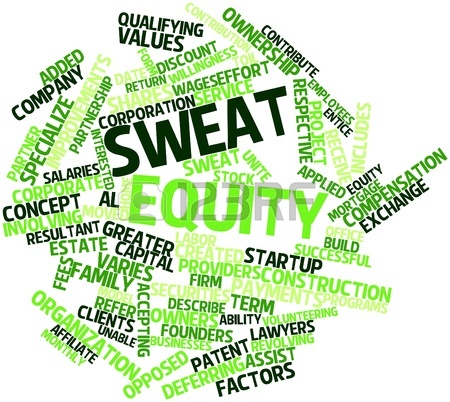Introduction
Sweat equity shares is a part of the equity which is unpaid labor employees and cash-strapped entrepreneurs put into a project. The sweat equity is defined by the Section 2(88) of the Companies Act, 2013. The issuance of sweat equity shares is governed by the Companies Act, 1956 and the Companies Act, 2013.

The sweat equity shares mean shares issued by a company to its directors or employees for non-cash consideration or at a discount for making rights available in the nature of intellectual property rights or providing know-hows or any providing any value additions in any form. Sweat equity shares are issued either by way of discount or consideration other than cash. They allow employees/directors to participate in a part of the company’s profits as a return on their investment.

The term sweat equity refers to a person or company’s contribution toward a business venture or other project. Sweat equity is generally not monetary and, in most cases, comes in the form of physical labor, mental effort, and time.
How it works
Sweat equity originally referred to the value-enhancing improvements generated from the sweat of one’s brow. So when people say they use sweat equity, they mean their physical labor, mental capacity, and time to boost the value of a specific project or venture.
The term is commonly used in the real estate and construction industries. Sweat equity can be used by homeowners to lower the cost of homeownership. Real estate investors who flip houses for profit can also use sweat equity to their advantage by doing repairs and renovations on properties before putting them on the market. Paying carpenters, painters, and contractors can get extremely pricey, so a do-it-yourself renovation using sweat equity can be profitable when it comes time to sell.
Sweat equity is also an important part of the corporate world, creating value from the effort and toil contributed by a company’s owners and employees. In cash-strapped startups, owners and employees typically accept salaries that are below their market values in return for a stake in the company, which they hope to profit from when the business is eventually sold.
Sweat equity can also be found in the relationship between landlords and their tenants. In exchange for maintenance work, building owners and landlords may provide an equity stake in the property or, in the case of a superintendent, free housing.
As per Section 2(88) of the Companies Act, 2013, employees covered under the scheme are:
- Directors
- Employees
A company can issue sweat equity shares up to the higher of the following:
- 15% of its existing paid-up equity share capital in a year
- Equal to the value Rs 5 cr
The fair price of such equity shares to be issued is ascertained by a registered valuer, who is also required to justify their valuation. There are taxations also involved in some of the cases.
These sweat equity shares might confuse you with the employee stock option plan. But, that is a whole other thing.
Difference Between Sweat equity shares & ESOP
| Particulars | ESOP | Sweat Equity Shares |
| Nature |
ESOPs are issued in the form of an incentive and as a retention plan to directors and employees. They do not create an obligation, and it is in the form of a right given to employees to exercise their option to purchase the shares.
|
Sweat equity shares are issued to the employees or directors as consideration for providing intellectual property rights or know-how or any value additions to the company. |
| Allotment |
ESOP is granted in the form of an option for the employees to purchase the shares at a predetermined price on a future date. These shares are allotted to the employee or directors only after exercising their option of the ESOP grant. |
Sweat equity shares are directly allotted to the employees or directors at a discount or for consideration other than cash. |
| Eligibility |
1. A permanent employee of the company who is working in India/outside India. 2. A Director of the company, which includes a whole-time/part-time director but not an independent director. 3. A permanent employee or director of a subsidiary company in India or outside India, or holding company, or an associate company. But the following employees are not eligible – 1. An employee who belongs to the promoter group or is a promoter of the company. 2. A director who, either himself or through any body corporate or through his relative, holds more than ten per cent of the company’s outstanding equity shares, whether directly or indirectly. |
1. A permanent employee of the company working in India/outside India.
2. A Director of the company whether a whole-time or not. 3. A permanent employee or director of a subsidiary company in India or outside India or holding company. |
| Consideration | The consideration for ESOP has to be paid in cash. |
The consideration for sweat equity shares is other than cash or at a discount which may be partly cash and party non-cash. |
| Lock-in Period | The company decides the lock-in period. |
The lock-in period is three years as per the Companies (Share Capital and Debentures) Rules. |
| Pricing Guidelines |
The company decides the exercise price. There are no pricing guidelines defined under the Companies (Share Capital and Debentures) Rules. |
A registered valuer determines pricing guidelines. |
| Restrictions | The company has no restrictions for issuing or granting ESOPs. |
The company cannot issue sweat equity shares in excess of 15% of the already existing paid-up equity share capital in a particular year or shares of the issue value of Rs.5 crores, whichever is higher. Also, the sweat equity shares in the company should not be issued more than 25% of the paid-up equity capital of that company at any time. |
Conclusion
Sweat equity shares are beneficial to both the issuing company and the employee or directors who receive them. It helps the business retain its talented human resources and also raise funds in its initial stages without availing debt. To the employees, their sweat is rewarded appropriately and in case the company grows by leaps and bounds over time, as they can reap handsome returns.




